Choosing the right substitute comes down to who owns your website updates and how quickly campaigns need to launch.
Introduction
Drupal has powered enterprise websites for years. Times are changing and teams are looking to get more control and reduce complexity. When every layout change depends on developers, testing new ideas takes longer, campaigns get delayed, and growth takes a hit.
In 2026, marketers expect CMS tools that support their hypothesis and campaigns without engineering roadblocks (or at least with less of those). That’s why brands look out for alternatives that keep the site moving and revenue flowing, even when developers are busy with things they actually should be focused on, engineering product features.
This guide breaks down the best options based on how marketing-friendly they are: easier content edits, reusable components, faster launches, and less maintenance. Use the comparison below to pick the CMS that lets your team ship faster and stay competitive.
What to Look for in a Drupal Alternative
To evaluate alternatives to Drupal, ask the following questions:
- Can marketing update and build pages without developers?
- Can we reuse layouts and components across the site?
- Can we launch and test pages fast?
- Is SEO easy to manage without add-ons and plugins?
- How much maintenance and security work is required?
- Will the site stay fast as the sitemap grows?
- What is the cost of platform including the developer time?
A modern CMS should help your team move faster and publish confidently. The platforms below make that possible.
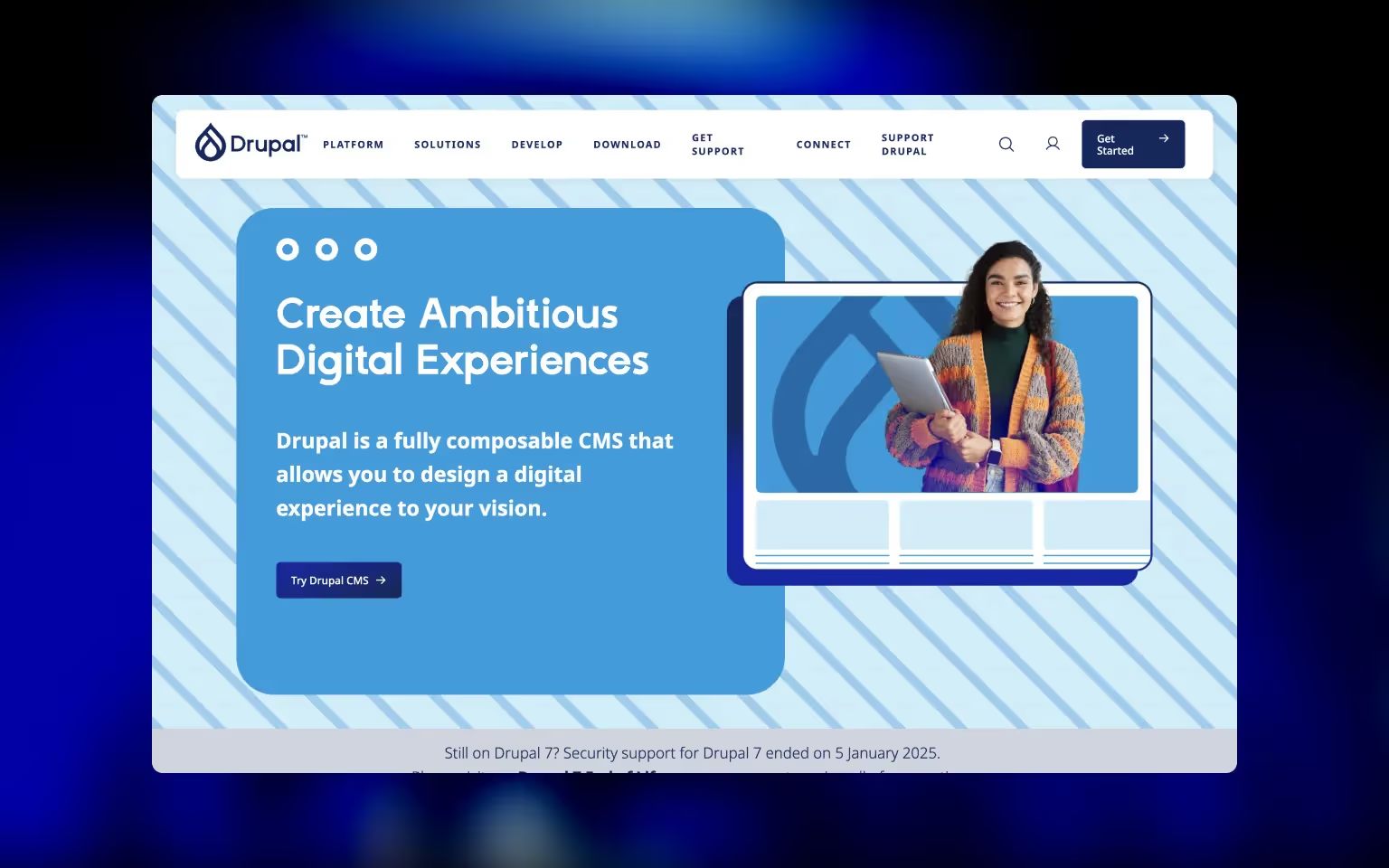
#1 Webflow – Best Overall for Visual Control & SEO
Webflow gives marketing teams the power to build and update pages without waiting on developers. You can launch new layouts using reusable components, make edits visually, and keep everything consistent with your brand system.
Why Webflow beats Drupal for marketing:
- Marketing can ship changes without engineering tickets
- Faster page launches with reusable components and templates
- Core SEO features included, no plugins needed. We cover those in our Webflow SEO guide
- Clean hosting and code output improve speed
- Lower maintenance overhead for engineering teams
Where Webflow is different
- Visual CMS that supports large structured content models
- Enterprise permissions for marketing and content teams
- Built-in localization for multilingual website management
- Conditional content logic for personalization at scale
- Robust designer-control layer without sacrificing brand quality
Best for: Teams that want speed, flexibility, and control over their website while reducing engineering dependancy for marketing.
Need help migrating to or building in Webflow? Our team specializes in helping B2B brands boost their marketing impact through Webflow. Explore our Webflow development services.
Want to know more about how we measure impact? We built a website ROI calculator just in case.
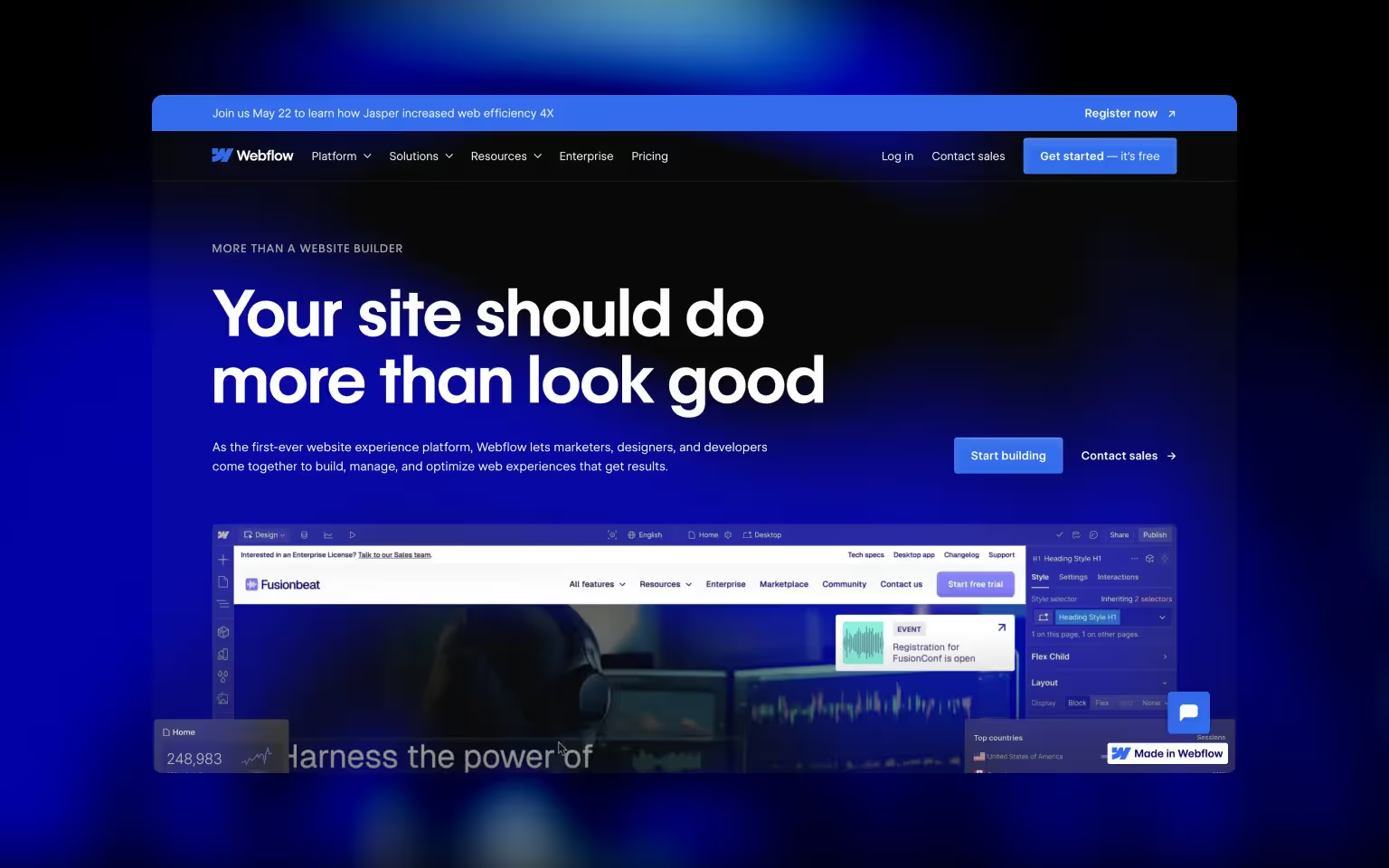
#2 Divhunt – Fast, Lightweight Builder for Modern Teams
Divhunt is a rising star in terms of site builder platforms. It focuses on speed, simplicity and familiarity. Sites built on Divhunt's Figma-like experience load fast because of the lightweight code output.
Why Divhunt beats Drupal for marketing
- Faster performance with minimal infrastructure
- Cleaner builds that avoid plugin or module bloat
- Easier for marketers to update without backend knowledge
- Lower maintenance demands on engineering
- Great value for smaller teams shipping fast
Where Divhunt is different
- Performance-first architecture for high-speed websites
- Figma-like editor that feels intuitive to designers
- More granular HTML control than most visual builders
- Simpler stack with fewer moving parts to break
- Quick learning curve for marketers and founders
Best for: Startups and agile teams who prioritize fast site speed and lightweight builds over complex enterprise features.
Compare it with Webflow: Webflow vs Divhunt
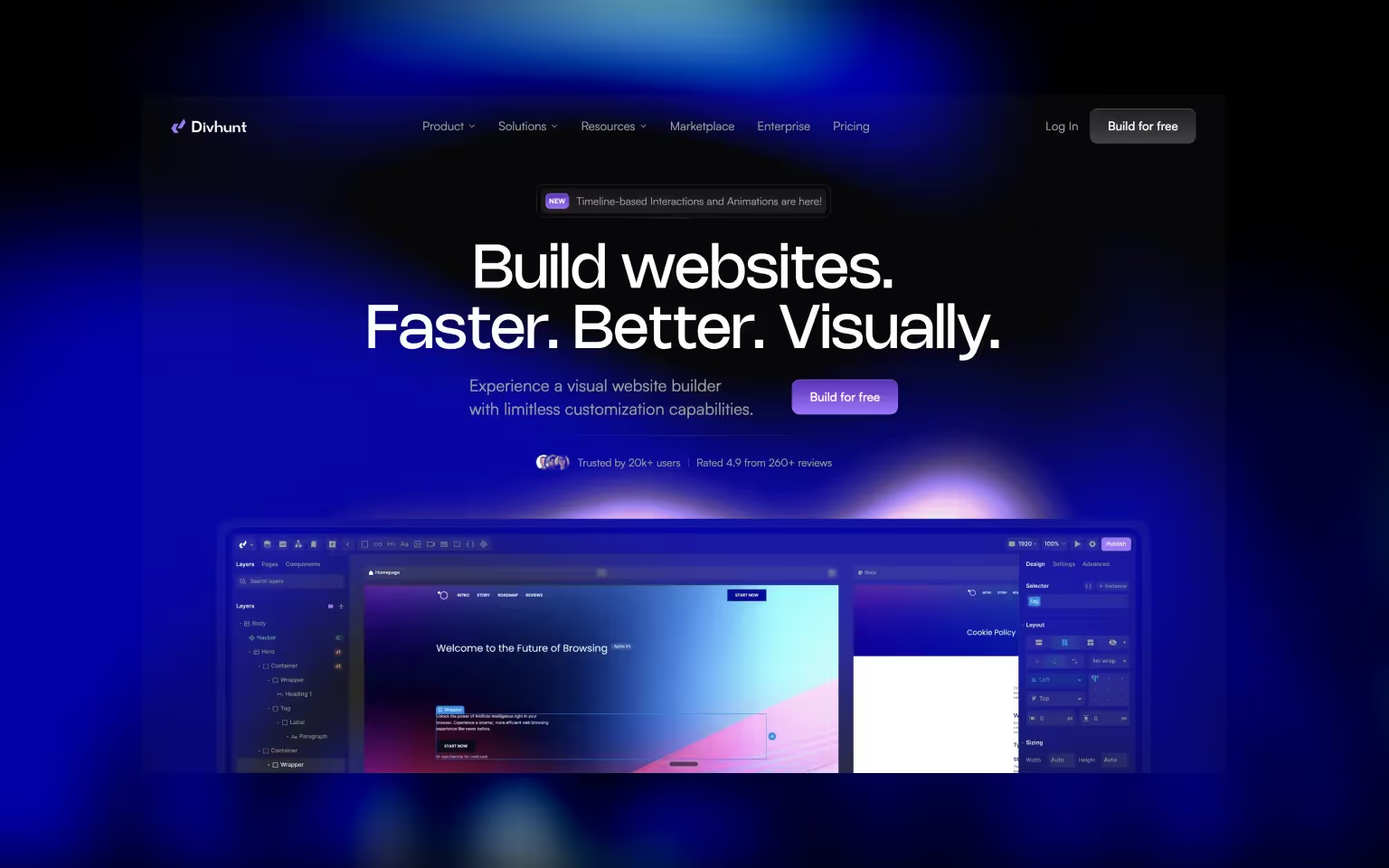
#3 WordPress – Most Flexible Open Source CMS
WordPress is so popular that it's used by over 43% of the websites worldwide. Compared to Drupal, it’s easier for content teams to use and has way more plugins and builders to choose from. The reason it sometimes feels confusing is because there are so many options, not because the platform is bad.
Why WordPress beats Drupal for marketing
- Easier editing and page management
- Huge library of plugins and themes
- Big community and lots of available help
- Great for publishing lots of content
- Cheaper to start with
Where WordPress is different
- The biggest ecosystem of builders and add-ons
- Works great for blog-first websites
- Tons of tutorials and templates available
- You choose your hosting and setup
Best for: Teams that want the most options and don’t mind handling updates, security, or occasional developer help.
If you want something, there is a plugin for it more likely than not. Still, someone has to take care of it.
Compare Webflow with WordPress options:

#4 Framer – Best for Startup Landing Pages
Framer is great for teams who want fast, beautiful landing pages without dealing with complicated backend work. Its UI is exactly like Figma, meaning it's ideal for design teams. Designers can create those pages themselves and push the site live without a need for developer. With that said, the generated code is not the cleanest and can be tough to maintain as the platform is based on React. This is where the dev resources may come in.
Why Framer beats Drupal for marketing
- Easier to build high-converting landing pages
- Faster to design and ship prototypes
- No backend setup or modules to maintain
- Strong animation and interaction tools
Where Framer is different
- Figma-like editor made for designers and motion
- Real-time collaboration in the same interface
- Built-in hosting with a global CDN
- Best for pages where visuals matter most
- Very simple CMS for straightforward content needs
Best for :Startups launching polished landing pages fast. Not ideal for complex CMS sites with lots of dynamic content.
Compare your options:
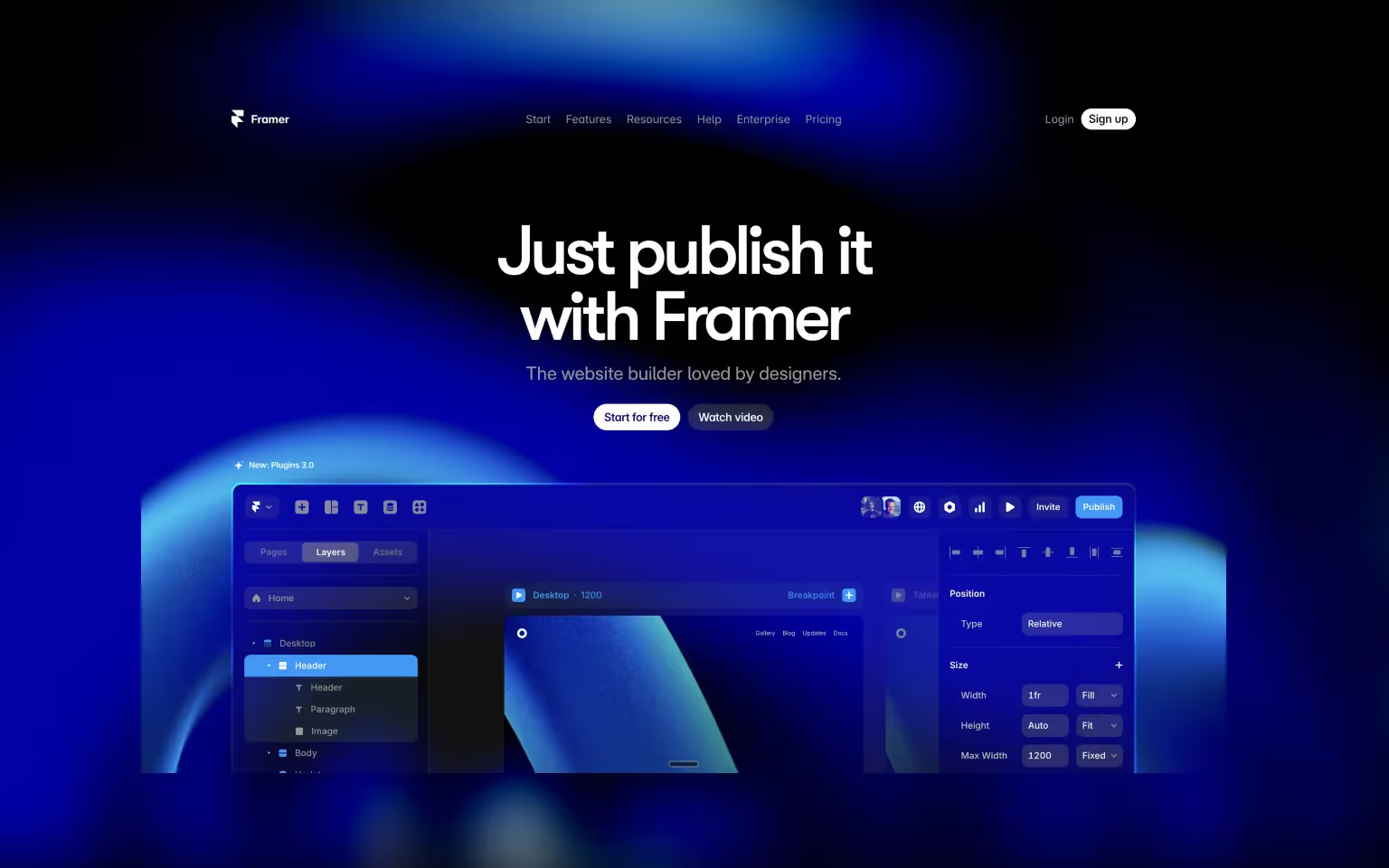
#5 Ghost – Fastest for Content-First Brands
Ghost is made for content marketing teams that want to focus on writing and publishing, not managing a complicated CMS. It’s fast, clean, and gives editors everything they need without the extra clutter.
Why Ghost beats Drupal for marketing
- Easier to use for publishing and content workflows
- Faster page loads with a lightweight framework
- Built-in SEO for better visibility
- Membership and newsletter tools included
- Minimal setup and maintenance required
Where Ghost is different
- Publishing-first platform designed for content as the product
- Cleaner writing experience than most CMS options
- Great fit for blogs, media brands, and newsletters
- SaaS or self-serve product depending on your needs
Best for: Teams who publish daily and want a simple, fast CMS with no technical overhead.
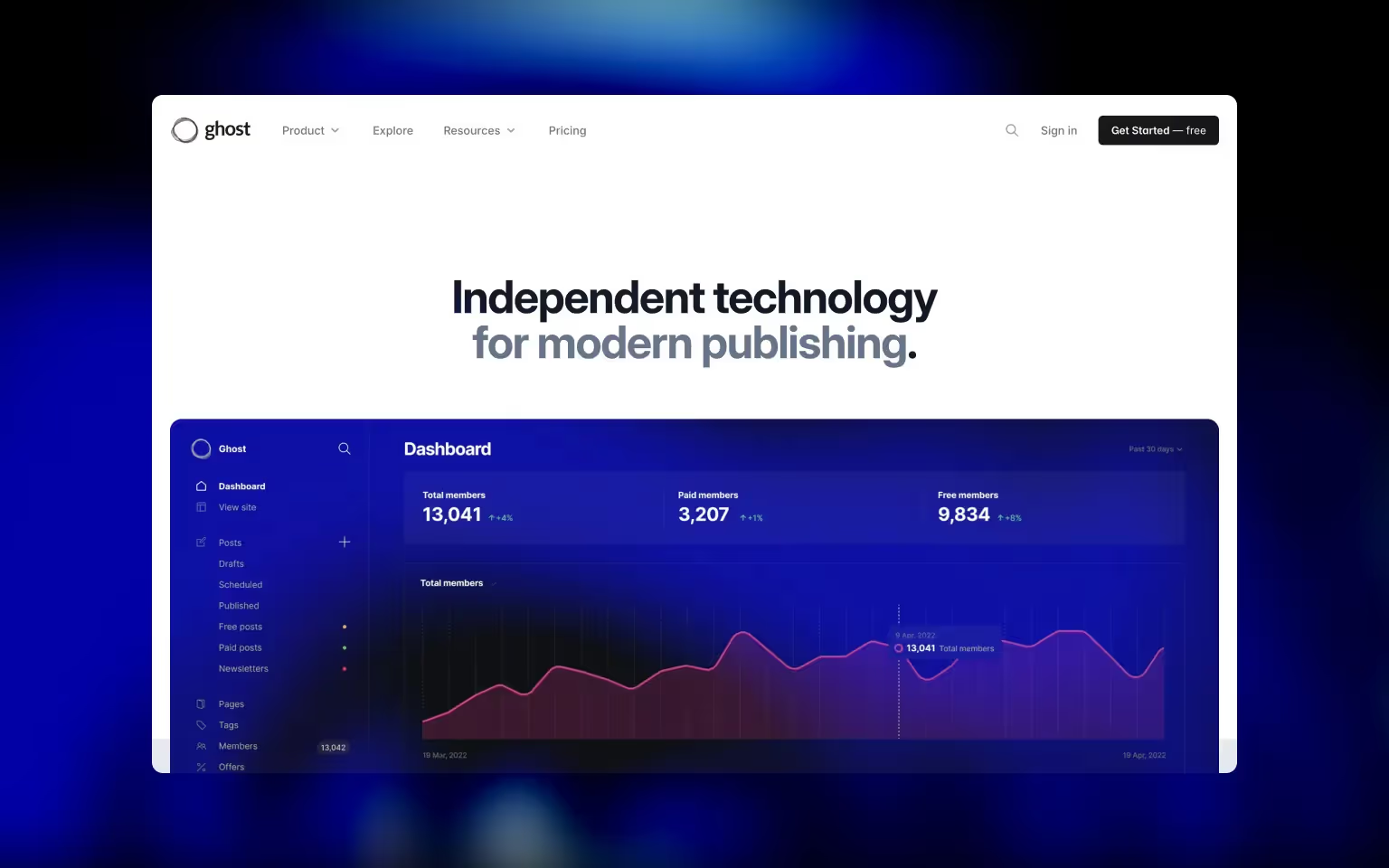
#6 Storyblok – Headless With Visual Editor
Storyblok gives you the flexibility of a headless CMS while keeping the features needed for marketers to preview and edit pages in a visual way.
Why Storyblok beats Drupal for marketing
- Faster to build and update content experiences
- Visual editing instead of working blind in a decoupled backend
- Reusable content blocks reduce duplicate work
- Built-in localization features for multilingual sites
- Easier to maintain with modern tooling
Where Storyblok is different
- Works with any modern frontend (React, Next.js, etc.)
- Live preview so editors see changes instantly
- Good permissions and workflows for large teams
- Still powerful for developers, not limiting
Best for: Teams that want headless flexibility without needing a developer every time they update text.
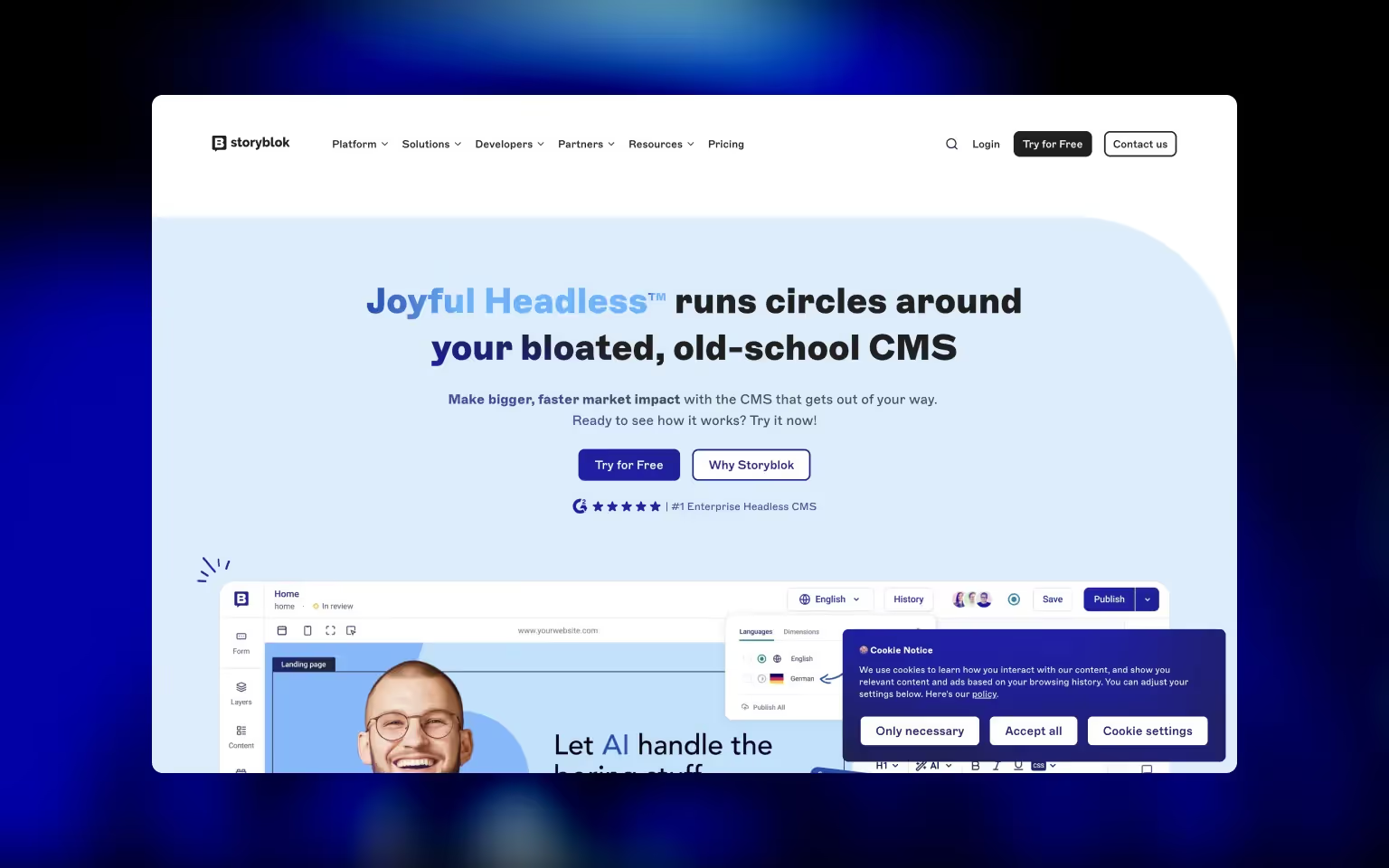
#7 HubSpot CMS Hub – Best for Inbound Marketing Teams
HubSpot CMS puts your website, CRM, email, and analytics all in one place. That means less tool-hopping and more focus on turning traffic into customers.
Why HubSpot CMS beats Drupal for marketing
- Website + CRM + email + analytics in one tool
- Personalization based on real customer data
- Strong SEO tools included, no extra plugins
- Reporting tied to leads and revenue, not just clicks
- Hosting, security, and speed handled for you
Where HubSpot CMS is different
- Built for inbound marketing first, not developers
- Automated lead nurturing connected to forms and CTAs
- Dynamic content based on lifecycle stage or behavior
- Campaigns and content live together in one system
- Great fit for sales-aligned teams with fast growth goals
Best for: Companies that want their website and marketing engine fully connected so they can grow faster and prove results.
Compare your options:
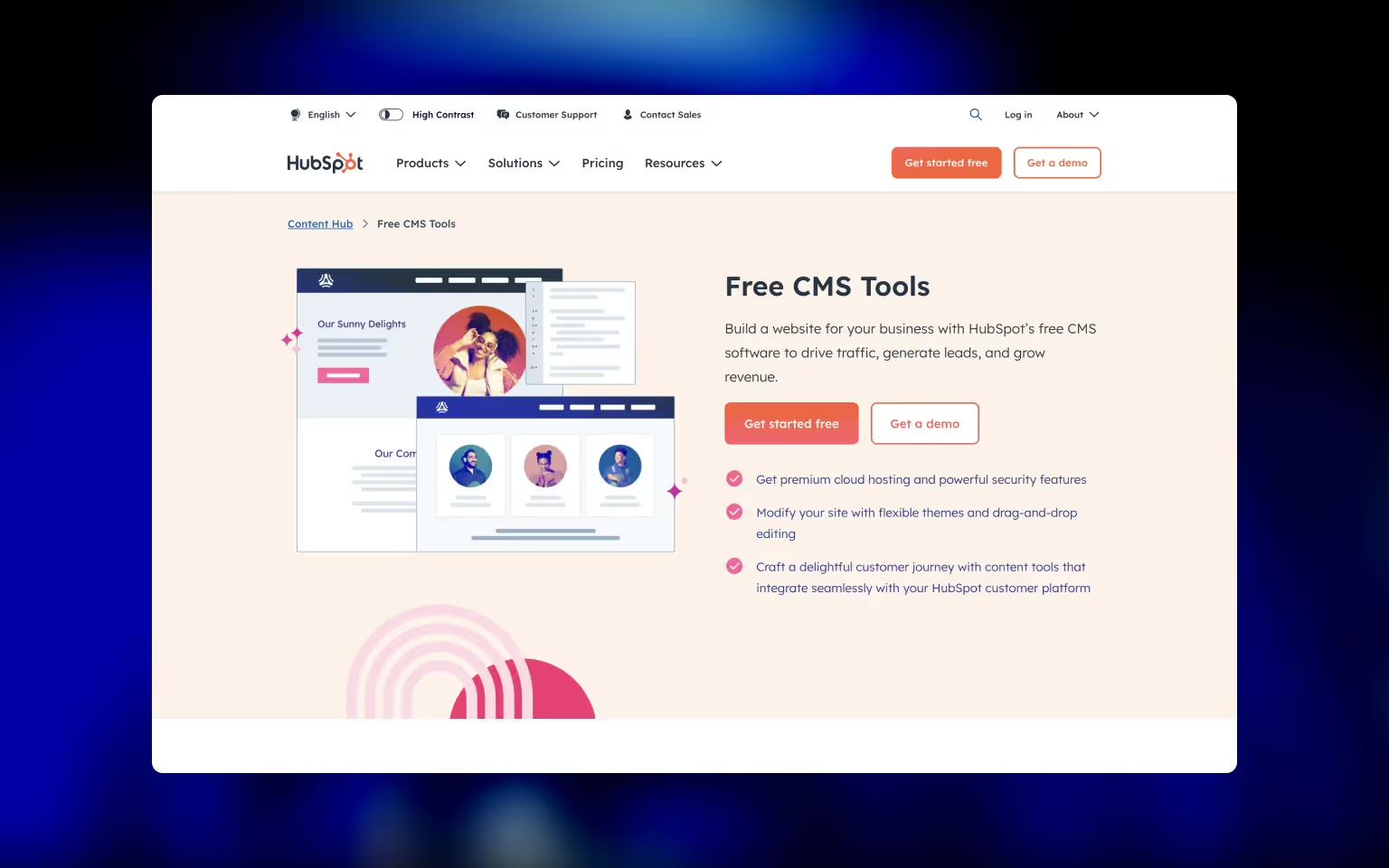
#8 Joomla – Open Source CMS With Built-In Multilingual Support
Joomla is a solid choice for teams that want open-source freedom with strong multilingual features without diving back into Drupal complexity.
Why Joomla beats Drupal for marketing
- Multilingual out of the box, no plugins required
- Advanced access control for content workflows
- Strong community and long-term ecosystem
- Flexible content structures without custom development
- Still fully open source and self-hosted
Where Joomla is different
- More structure than WordPress but less complexity than Drupal
- Built-in tools reduce reliance on extensions for basics
- Good option for teams with internal IT or dev support
- Stable choice for organizations with strict governance needs
Best for: Teams that need reliable multilingual support and content control in an open source system.
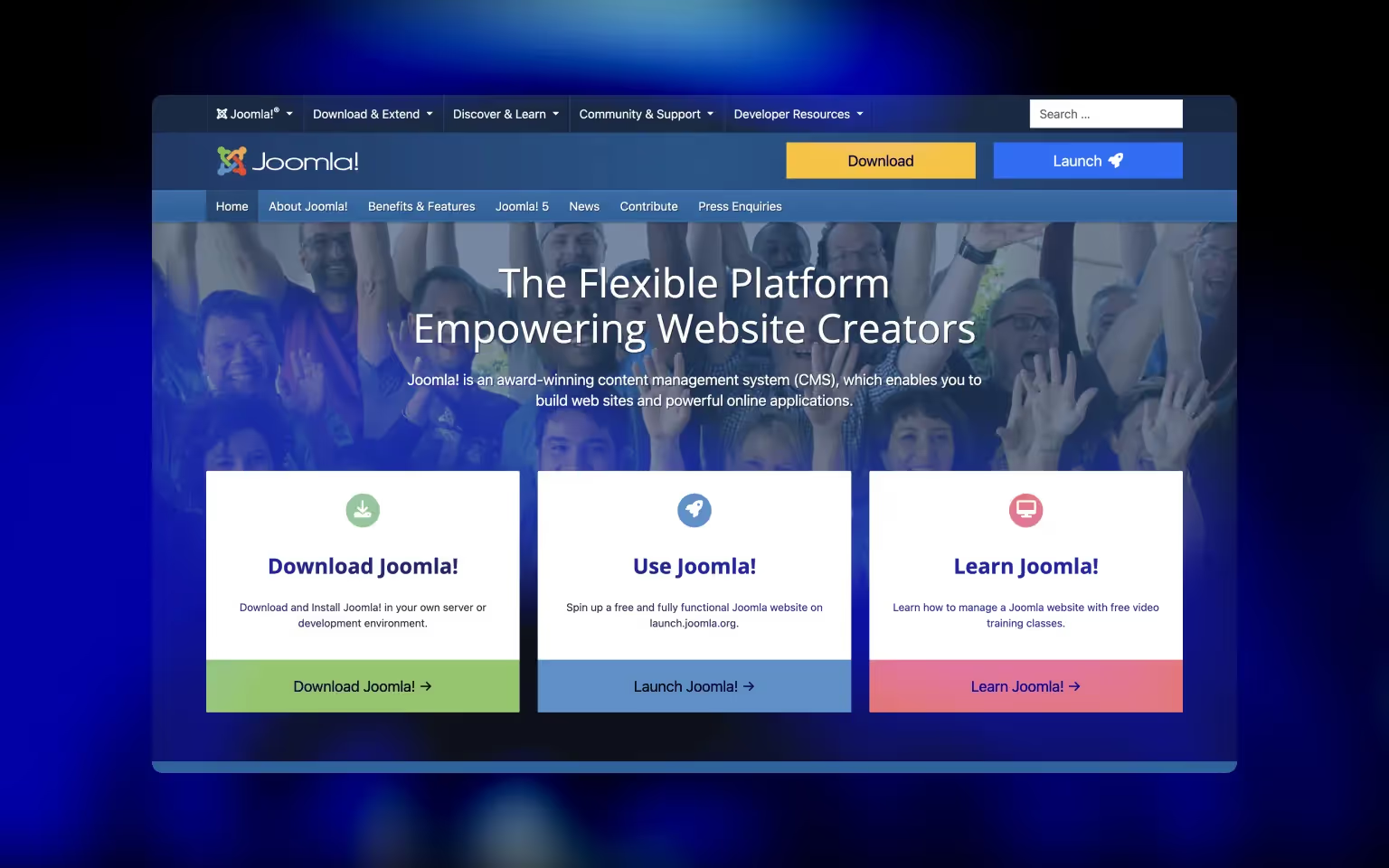
Why Webflow Is the Best Drupal Alternative
Webflow lets marketing teams update, launch, and test pages without waiting on developers, something Drupal has never made easy. Faster changes mean faster results.
Why Webflow leads the pack
- No plugins needed: Hosting, CMS, SEO, and security all in one place
- Visual control: Build and edit pages without touching code
- Reusable components: Launch new pages faster and stay on brand
- Better for SEO: Clean code, fast loads, built-in redirects
- Scales with your team: From startup sites to global enterprises
Bottom line: Webflow gives marketers control, speed, and confidence, while letting developers focus on product instead of website tickets.
Conclusion & Next Steps
Drupal still works well for big, complex sites. But most teams today want something easier and faster. When every small change needs a developer, marketing slows down, meaning incoming revenue slows down too.
The good news: there are better options in 2026.
If you want:
- More control over page updates, pick Webflow
- Very fast sites, pick Divhunt
- Simple publishing, pick Ghost
- Headless power, pick Storyblok
- Sales + marketing in one place, pick HubSpot CMS
So you chose the best platform and wonder what's next?
No matter what platform you chose, find a team that will help you switch from Drupal. Our team can help you make the transition to Webflow, Framer, or Divhunt. If that's something you're looking for, contact us.
FAQs for Drupal Alternatives
Does Drupal have a future?
Yes. Drupal will keep being used by governments and big organizations. But many marketing teams are switching to tools that are easier and faster to update.
Is Drupal still a good CMS in 2026?
Yes. Drupal is powerful and secure. But most changes require a developer, so marketing teams move slower.
What is the best Drupal alternative for marketing teams?
Webflow. Marketers can update pages themselves, launch faster, and keep the design consistent.
Which CMS platform is the best overall?
Webflow works best for most business websites.
Other good choices:
- Divhunt: Fast and lightweight
- WordPress: Many plugins
- Storyblok: Works well for headless builds
- HubSpot CMS: Tied directly to marketing and sales tools
Read our overview of the Best CMS for SEO.
Is Joomla better than Drupal?
It depends. Joomla has built-in multilingual support and fewer modules to manage. But Drupal is stronger for very complex websites with large tech teams.
What are the best Drupal alternatives for large companies?
Our take based on best to worst in terms of control, teamwork and downtime:
- Webflow Enterprise
- Storyblok
- HubSpot CMS
- WordPress
- Joomla
What are the best Drupal alternatives for developers?
Best to worst:
- Webflow (clean builds, less maintenance)
- Storyblok (full control for developers)
- WordPress (very flexible but plugins can break things)
- Joomla (old-school but still works)
- Divhunt (not great for large websites)




